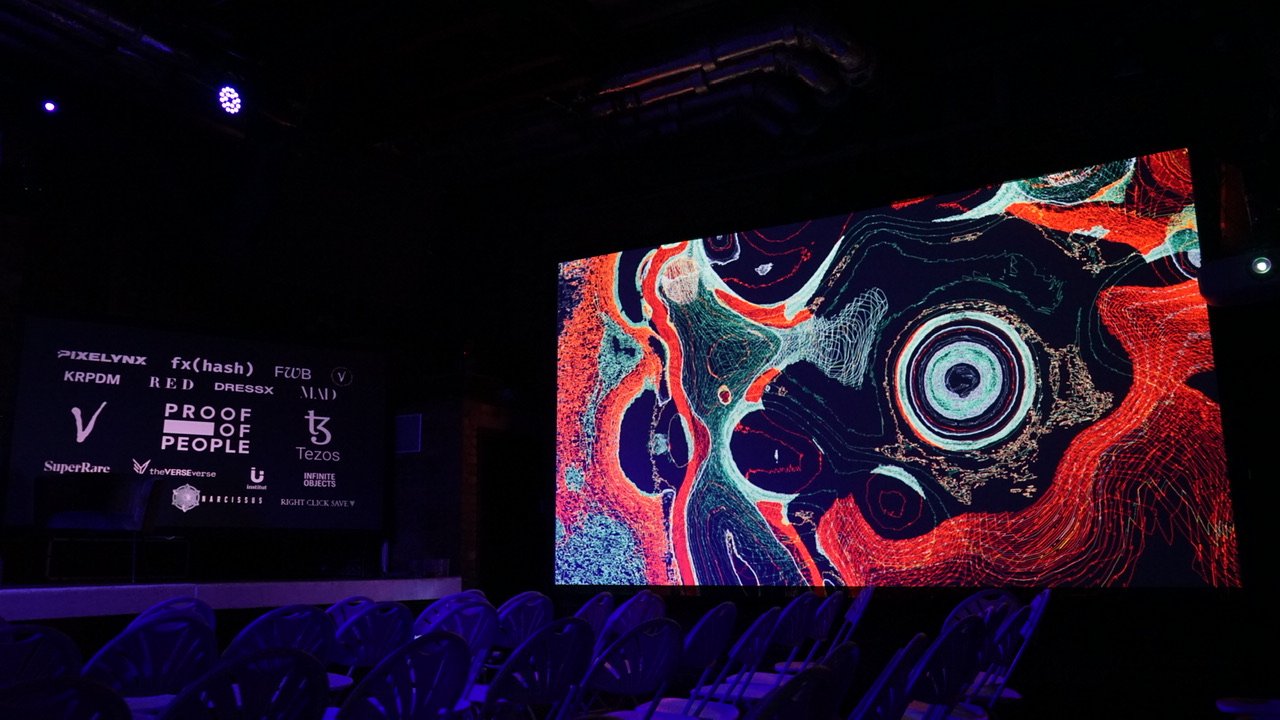MARGARET BY QUBIBI
This was part of an ongoing series of articles that released was digitally in May 2023. They were first published in the print edition of the Bright Moments Quarterly that was distributed at Bright Moments Tokyo in Tokyo, Japan.
Malte Rauch: Thanks so much for taking the time to do this interview, Qubibi! Tell us about your background and how you got started in generative art.
クビビさん、インタビューにお時間を割いていただき、誠にありがとうございます。あなたのバックグラウンドと、ジェネラティブアートを始めたきっかけについて教えてください。
Qubibi: I began exploring generative art in 2010. To be more precise, the piece I presented at that time, "hello world," is now considered generative art. If not for "hello world," I don't think I would have ever pursued generative art. In the NFT world, I've become known for the MIMIZU project which used an algorithm inherited from "hello world."
I've been using that algorithm for the past 13 years. I often create my work by being pulled into the process by the piece itself, without having much personal motivation behind it. Without my work, I feel a bit empty, to be honest... I think it's rare for someone to continue using one algorithm for 13 years. I never imagined I'd be so consumed by it. However, for me, there's no reason to use any other generative art algorithm since this system continues to inspire and surprise me.
僕のバックグラウンドはプロフィール文章を読めば大体わかりますからここでは割愛。こちらにあります。ジェネラティブアートをはじめたのは2010年からです。はじめたというより、その時に発表した作品「hello world」がジェネラティブアートといわれるものだった、というのが正しいです。ですから、hello worldがない限り、僕がジェネラティブアートに取り組むこともなかったと思います。また、NFTの世界ではMIMIZUといわれるプロジェクトで知られていくようになりましたが、そのMIMIZUで使われているアルゴリズムはhello worldから引き継がれているものです。ですから、僕は13年間ずっとそのアルゴリズムを使い続けているといえます。僕は作品に引っ張られるようにして作ることが多く、そこに自らの動機みたいなものがあまりないんですよね。だから、作品がなければ僕自身は空っぽというか…。
13年もひとつのアルゴリズムでやり続けている人は少ないと思います。僕自身も、まさかこんなに自らの時間を奪われることになるとは思ってもいませんでした。けれど、ジェネラティブアートにおいて他のアルゴリズムを使う理由が僕にはないのです。
What is the digital and generative art scene like in Japan? And how did it change through the emergence of NFTs?
日本のデジタルおよびジェネラティブアートシーンはどのようなものですか? また、NFTの出現によってどのように変化しましたか?
There is no end to what the digital arts can include, like games, for example. In Japan, Yugo Nakamura pioneered interactive play on the Internet and deepened the culture of digital art. In the 2000s, web designers around the world, myself included, were creating elaborate websites using Flash. However, with the decline of Flash, most of them may have disappeared.
In 2008, Yugo Nakamura released a display product called “Framed,” which was used only for viewing digital art, or rather, for “watching from the sidelines.” I think it was about 1.5 million yen at the time. Nowadays, there are signage displays at stations and dedicated displays for NFTs, but at that time, those things did not exist. I think it was ahead of the curve. In 2010, I released a piece of generative art as a digital art work exclusively for Framed. I don't really know what kind of people there were in Japan at that time. Even as for now, I still don't know though.
デジタルアートに何を含むか、たとえばゲームなども含みだすときりがないけれど…僕の身近なところで話すとすれば、日本では中村勇吾さんが先駆けてインターネット上にインタラクティヴな遊びを構築したことでデジタルアートの文化が深化したと思います。2000年代は僕含め世界中のウェブデザイナーがFlashを用いて趣向を凝らしたウェブサイトを作っていましたが、日本は中村勇吾さんの存在により豊かな「土壌」があったのではないでしょうか。とはいえ、Flashの減退とともにみんな居なくなったかも…。
そういえば、2008年、中村勇吾さんはFramedというデジタルアートを閲覧…というか「傍観」する為だけのディスプレイ製品を世にだしたんです。当時150万くらいしたと思う。今では駅のサイネージディスプレイや、NFTを再生する専用のディスプレイなどがあるけれど、当時そんなものはこの世になかった。先駆けていたと思います。そのFramed専用のデジタルアート作品として、ジェネラティブアートといえる作品を僕がリリースしたのは2010年。当時日本に他にどのような人がいたか、よく知らないんです。今はどうかというと、今もよく知らない
What are the key influences in your work as a generative artist?
ジェネラティブアーティストとしてのあなたの作品に影響を与えた主なものは何ですか (伝統的なアーティスト、他のジェネラティブアーティスト、自然現象など)?
From the point of view of generative processes, I guess games are a big influence. I don't consider myself to be a generative artist, but I think one of the factors that made this happen was the enjoyment of "watching from the sidelines." I've been immersed in games since I was a child. I was fascinated by the demo play that played after I left the title screen. In other words, it's the joy of moving freely. It's actually not that fun to be able to directly operate it as you wish. It's funny because I don't understand it. I feel lost when I understand everything.
I'm not a person who has studied a systematic curriculum, and I'm not creating something with admiration. My timeline basically has no future. Please don't take this negatively. There are more than a few people who have only the past and the present without thinking about what they want to be.
A friend of mine once told me: "It's very interesting that the pictures that Teshigahara drew when he was a teenager are very similar to the series of generative works he's doing now, starting with hello world." At that time, I was drawing pictures and liked Beardsley and Vallotton – a very dark realm that I almost got sucked into. It may still influence the way I approach composition.
If I were to mention other influences, I would say the exciting art I encountered in my teens: the music, the movies, HyperCard and CD ROM works, web art from the 2000s and Dushan Magavayev's "sweet movie".
By the way, all of these stories are simply speculations. I don't know what influences me. I can only speculate that this may have had an effect on me looking back now.
ジェネラティブという観点でいえば、やっぱりゲームだと思います。僕はジェネラティブアーティストという自覚はありませんが…でもそのきっかけを作った要素に「傍観」する楽しみというのがあるように思います。幼少の頃からゲーム漬けだった僕は、タイトル画面を放置した後に流れるデモプレイに惹かれました。つまり、勝手に動いていることの楽しさですよね。自分で直接的に思い通りに操作できることって、実はそんなに楽しくない。間接的なほど、わからない。わからないからこそ面白い。わかっちゃうと寂しい。
僕は体系だって学んできてる人間ではないし、なにかに憧れを持って今作っているわけでもありません。基本的には未来がない人間です。これをネガティブに捉えないでください。ああなりたい、こうなりたい、なんてことを思うこともなく、過去と今しかない人間、というのは少なからずいるのです。
さて、昔友人にこのように言われたことがあります。「勅使河原が10代の頃に描いていた絵が、今やっているhello worldからはじまる一連のジェネラティブアートに極めて似ているというのはとても興味深い」…当時、絵を描いていた僕が好きだったのはビアズレーやヴァロットンです。ぞっとするような大胆な黒い領域。そこに吸い込まれそうになった。僕の構図感に今も影響を与えてるかもしれないです。
そのほかに影響を与えているものを挙げるとしたら、10代の頃に出会った刺激的なアート…音楽や映画、HyperCardやCDROMの作品、2000年代のWEBアートなどがありますが、ひとつだけ挙げるとしたら、ドゥシャンマガヴァイエフのスイートムービーです。おそらく。
ちなみに、こうした話は全部あとからの推測です。なにが自分に影響を与えるか、なんてわからない。今から振り返ったらば、これが自分に影響を与えたのではないか?という推測でしかないのです。
You often work with curated outputs from an algorithm. What do you think about the difference between curated outputs and long-form projects?
アルゴリズムからキュレーションされたアウトプットを扱うことがよくあると思います。キュレーションされたアウトプットとロングフォームのプロジェクトの違いについてどう思いますか?
They are completely different and I still struggle to think about it. Long-form projects are very difficult. With it, art tends to become like a slot machine game. I like it – it’s a lot of fun! Collectors are excited to see what will happen. Even if the artwork is defined by a simple structure, it’s difficult to gauge how it will be tolerated by the long form. So I am very careful about how far I will go. Of course, it reduces the pain of choosing for artists, but that is not necessarily a good thing. The act of choosing is important. This is about balance, not a decision between 0 and 1. And I believe the reason for my current perspective may be influenced by my extensive experience in interactive work. The manner in which I approach organizing and prioritizing options, through narrowing and expanding criteria, was cultivated during my time working in interactive settings.
With that in mind, if there is a curator with good taste who supports artists, I need to make the work significant.
それらは全然違うし、僕は未だにそれについて悩みます。ロングフォームのプロジェクトというのはとても難しい。アートが、ともすればガチャ的なゲームになってしまう。そりゃ楽しいにきまってるんです。買っちゃいます。なにがでるかな〜?とお楽しみなんだから。つまり、安易な作り込みの作品だとしてもロングフォームのその仕組みにより許容されてしまう可能性があります。だから、どこまでやって良いのか僕自身は慎重になります。勿論、作家としては選ぶ苦しさは軽減しますが、それが決して良いこととは限らない。選ぶ行為は大切です。これはバランスの話。しきい値の話でもあります。0か1かではない。それは僕が、選択肢を狭める、広げるといったことへの接し方や順番において、元々インタラクティブの仕事をしてきた人間だということが影響しているのかも。
そんなことも踏まえた上で、アーティストをささえるセンスの良いキュレーターがいたならば、大切にしないとと思っています。
What are your expectations for the Bright Moments Tokyo event? And how does the Japanese public think about web3 and crypto art?
Bright Moments Tokyoのイベントに期待することは何ですか? また、日本人はWeb3とクリプトアートについてどのように考えているのでしょうか?
What I expect is to have a good time with the people who come to Japan. What will the Japanese people think? The Japanese people I interact with don't seem to be very interested in crypto art, so I am curious to see what the reaction of locals will be like.
期待することは、日本にやってくる人々と楽しい時間が過ごせることです。日本人がどう考えてるか….僕が交流のある日本人はなぜかあまりクリプトアートについて興味がないようで、それについてはわかりません。
What are you working on for the Bright Moments event in Tokyo?
東京で開催されるBright Momentsイベントに向けて、どのような作業を行っていますか?
When it comes to starting a project or realizing when the time is right, I believe that it's important to do nothing at all. Creating a sense of empty space is essential for realizing when the time has come for generating ideas. To create this space, I engage in various random activities – such as checking emails.
制作がはじまる時…つまり来るべき時を迎える為には、または来るべき時に気づく為には、何もしないということが重要になると思うんです。そうした漠然とした空白を作るべく、色んな作業をしています。たとえば…メールチェックとか!
The idea of IRL (in-real-life) minting is unique to Bright Moments. How do you approach this concept? And what experience would you like to evoke in the viewer?
IRL (インリアルライフ) ミントのアイデアは、Bright Moments独自のものです。 このコンセプトにどのようにアプローチしますか? 視聴者にどのような体験を呼び起こしたいですか?
I'm still undecided on how to approach it. And I try not to think about what kind of experience I want to evoke in the viewer. The more I think about it, the less likely it is to happen. Not thinking about it is what makes it happen. Once I see it, I can't see it. I can see by not seeing. It sounds like a Zen story, but I think it's true (at least at a certain stage of creativity). It's very difficult though.
どうアプローチするかはまだ未定です。そして受け手にどのような体験を呼び起こしたいかという点については、考えないようにしています。それを想うほどそれは実現しない。それを想わないことでそれが実現する。見てしまったら見ることができない。見ないことで見ることができる。まるで禅の話のようだけど、(少なくとも制作のある段階においては確実に)それが当てはまると思ってるんです。とても難しいけれどね。
What does the future hold for web3 and crypto art in Japan? What would you like to see emerge in the country?
日本におけるWeb3とクリプトアートの未来はどうなる? この国に何が出現することを望みますか?
I tend to feel anxious when I think about the future. I guess you could say I'm a worrier! (laughs) I often wish for a form of happy solitude that could help ease my mind. I believe that the formation of culture plays a significant role in achieving this. That's why I think art, including crypto art and digital art, can be instrumental in shaping this kind of experience.
未来を考えると不安しか思い浮かばない性格です。心配性なので(笑)。 幸せな孤独のかたちがあれば良いなと思います。それには文化の形成が大きく関わってるので、クリプトアート含めデジタル世界でのアートもその一旦を担っているはずです。




